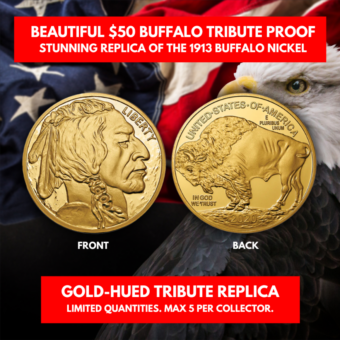How Much Gold is in Fort Knox and Who Owns It?
Fort Knox, more formally known as the United States Bullion Depository, has long stood as a symbol for impenetrable defense. It’s no secret that the army post has been home to mountains of gold bars secured under some of the best security measures available. The name of the location alone is synonymous with security and wealth. Still, some people are beginning to hypothesize that the gold holdings that once resided there are no longer in place.
In many ways, Fort Knox is a mystery. Rightfully so given the tremendous wealth that is reportedly stored there. In spite of the many conspiracy theories created to fill the gaps in knowledge about Fort Knox, this article will examine what is currently reported as true by the U.S. government. This truth is that there is a staggering amount of gold stored in Fort Knox and, surprisingly to many, there is a staggering amount of gold stored in other locations too.
Counting Up the Fort Knox Gold
The United States Bullion Depository holds a majority of the United States gold reserves in one location. It is located just down the road from the Fort Knox, Kentucky army base, and boasts some of the greatest security anywhere. As of the last report on March 31, 2020, the vault at Fort Knox holds 147.37 million troy ounces of gold. That is roughly 4,583 metric tons of gold bars with a book value of around $6.2 billion and a current market value close to $236 billion. And, as if those figures weren’t large enough, this only amounts to around 56% of all the gold reserves in the United States.
All this gold is held in the form of bars measuring seven inches long, three and a half inches wide, and one and three-quarters inches thick. While each bar contains about 400 troy ounces of gold they aren’t all the same quality. A 2011 report on the exact count and composition of the U.S. gold reserves helped clarify what is present. The report found that about 64% of the bars have a fineness between 899 and 901, 2% of them have a fineness between 901.1 and 915.4, 17% have a fineness between 915.5 and 917, and 17% have a fineness greater than or equal to 995. The average fineness was found to be 916.7.
Each bar weighs over 27 pounds and there are around 368,000 bars in total stacked in the vault. A single bar could earn you upwards of $640,000 in today’s market, that’s if you could sell it of course. Each bar is likely to be marked with a distinct stamp that is known to only a few depository staff members. The gold in the vault at Fort Knox is meant to stay there until the U.S. government deems otherwise.

The United States government controls a huge amount of gold wealth through their depositories. The United States Department of the Treasury oversees all this wealth.
That’s Not All of the Gold
Fort Knox holds a majority of the U.S. Treasury’s deep storage gold reserves with 56% of the total gold reserves being stored there. In addition to the 147.37 million troy ounces of gold at Fort Knox, there is another 54 million troy ounces at West Point and still another 43.8 million troy ounces in Denver, CO. The total of these gold reserves amounts to 8133.5 metric tons of gold making the U.S. gold reserves roughly equal the total gold reserves of the next three countries combined.
This massive gold supply outweighing the gold reserves of all other countries leaves the United States in a position of tremendous economic leverage. For example, back in 2013 the small country of Cyprus simply considered selling off their gold reserves to help handle their debt crisis. In response to their ruminations, global gold prices plummeted. That price drop contributed to already unstable economic conditions around the world.
Now, the United States roughly holds 330 times more gold reserves than Cyprus. Actually, Fort Knox alone holds a significantly higher amount of gold reserves compared to Cyprus. It isn’t hard to imagine what would happen if the United States attempted to sell off even a portion of their gold reserves. It is this sort of economic leverage that has made the gold reserves of the United States a deeply political and emotional topic for some.
Who Owns All That Gold
So, since Fort Knox and the other depositories hold enough gold to massively influence global economics, who owns all of it? Well, the sole official owner of all 8133.5 metric tons of gold is the U.S. Department of the Treasury (USDT). The USDT is the national treasury for the federal government of the United States overseeing the agencies responsible for printing paper currency and coins, such as the U.S. Mint. The USDT is also responsible for the collection of taxes through the Internal Revenue Service (IRS) among many other responsibilities.
The U.S. Department of the Treasury is essentially the executive department that deals with all things of monetary value in the United States. The other significant organization in this regard is the Federal Reserve which serves as the central bank of the United States. The head of the USDT is the Secretary of the Treasury who is a member of the president’s cabinet and is nominated by the president of the United States. As of early 2020, the incumbent Secretary of the Treasury, as appointed by President Trump, is Steven Mnuchin.
Other Treasures in Fort Knox
One of the many lesser-known facts about Fort Knox is that it has held more treasures than just gold over its lifetime. Currently, in addition to the tons of gold sitting in the underground vault, Fort Knox also holds ten 1933 Double Eagle Gold Coins, a 1974-D aluminum penny, and twenty gold (22-karat) Sacagawea dollar coins that flew on the Space Shuttle. It isn’t a stretch of the imagination to assume that one of the United State’s most impenetrable vaults overseen by the Treasury Department also currently holds many other undocumented treasures.
Throughout history, the vault has stored many other valuable items as well. World War II, in particular, marked a period of great uncertainty that drove many treasures into hiding underground. As cities were bombed and the German advance seemed inevitable, the Librarian of Congress at the time, Archibald MacLeish, pushed for valuable documents to be secured in bomb-proof vaults in the United States. Fort Knox was offered as the solution and a few cubic meters of space were made to hide essential items.
Originals of the Constitution of the United States, the Declaration of Independence, Lincoln's Second Inaugural Address, Lincoln's Gettysburg Address, a Gutenberg Bible, the Articles of Confederation, and Lincoln Cathedral's exemplified copy of Magna Carta were sealed in climate-controlled boxes and tucked away under the Earth. As the threat of war eventually passed these documents were later removed and returned to the Library of Congress. Still, after the war, other artifacts made their way into the vault for protection.
At one point the depository held the Crown of St Stephen along with other Hungarian precious artifacts. The Royal Hungarian Crown Guard feared these irreplaceable items would fall into Soviet hands as the USSR rose in power. Years later the artifacts were eventually returned to Hungary. Although not at Fort Knox, one interesting item stored in the vaults of the U.S. Treasury was opium and morphine. This was kept at the West Point Mint in response to the needs of the Cold War. Current reports show that neither the opium nor morphine are still being stored there though.
How Secure is Fort Knox?
Visitors outside the Treasury Department are typically not allowed on the grounds of the U.S. Bullion Depository. This rule is taken so seriously that guest visits can be counted on one hand. President Franklin Roosevelt visited the site in 1943, members of the US Congress and the media visited in 1974 to assuage rumors all the gold had been sold off, and the third major tour was by current Treasury Secretary Steve Mnuchin accompanied by other senators and congressmen. The last Treasury Secretary to visit the grounds was in 1948.
Consider that last fact for a moment. Fort Knox is so secure that the Treasury Secretary, who runs the executive department that owns the gold in the vault, rarely even visits the facility. The U.S. Bullion Depository is typically strictly accessed by essential personnel only. This policy alone makes it one of the more secure government buildings in the world. Imagine though that you wanted to break in and take a bar of gold. What would that entail?
Well, first you would have to access the grounds. You might get as far as the visitor center before someone enquires who you are and why you are there. The depository itself is situated in an open field with full visibility in all directions so there isn’t anywhere to hide. Each corner of the building has a guard tower too. Just to access the building you would have to breach fences, razor wire, and minefields all under constant surveillance with high-resolution night vision and microphones. If you got that far you would then have to get into the building itself. This main building above ground is made of tons of solid granite and concrete reinforced with steel. The structure could withstand multiple bomb blasts and still hold strong.
So, let’s say, somehow you managed to get that far. You still aren’t near the gold yet. Next, you would have to make your way through security forces to the underground vault. The vault is made of steel plates, steel I-beams, and steel cylinders all encased in concrete. Again, this is resistant to multiple bomb blasts and not likely to be something that a person could make their way through. Your best bet would be going through the vault door.
The vault door is a beast unto itself though. It is made from 21 inches of high impact material, with a 25-inch vault casing and weighs in at around 18 metric tons. The door is almost never opened and is set with a 100-hour time lock that can only be opened by separate members of the staff using combinations that only they know. This should leave you with the daunting realization that even if you broke through all the other defenses you would still need to wait over four days for the vault to open. Needless to say, Fort Knox is nearly impenetrable.
The History of Fort Knox
Plans for the construction of the U.S. Bullion Depository began in 1935 when the U.S. Treasury announced their desire to build a gold depository on the grounds of Fort Knox, Kentucky. The idea behind this plan was to move gold from more vulnerable coastal locations like New York and Philadelphia and place it in locations better insulated against military invasion. This exact thinking is what had already led the Treasury to have over 2,600 metric tons of gold moved from San Francisco to Denver where it now resides.
From the initial announcement in 1935, it only took builders about a year and a half to complete the construction of the gold vault. By the end of 1936, the United States Bullion Depository was mostly completed and only slightly over budget. The Treasury Department wasted no time moving gold to their new depository and the United States Post Office began to make semi-weekly shipments starting January 11, 1937. The entire act of moving the gold was a massive militarized operation.
From end to end police escorts, armored vehicles, machine guns, and the military were employed to protect the gold. Armored train cars were used to move the gold across the country and each shipment was guarded by mint guards, secret service agents, soldiers, and even postal workers. Between the first big push in 1937 and another in 1940/1941 the new depository soon held 65.58% of the United States gold reserves. This amounted to 635.2 million troy ounces (19,757 metric tons) stored in the U.S. Bullion Depository by March of 1941.
Oddly enough, less than a decade earlier when construction began, the U.S. gold reserves sat around 194 million troy ounces in total. By 1939 that had jumped to 503 million troy ounces and continued from there. Much of this came in from gold imports from abroad as the U.S. earned a greater and greater perception as a safe haven for capital. Moving into the 1940s the United States held an impressive 628.4 million troy ounces of gold accounting for almost 80% of the world’s gold reserves.
As previously mentioned, the following years of the depository saw it host documents of historic significance and precious Hungarian treasures. In 1971, when President Nixon completely abandoned the gold standard, conspiracy theories began to rise that there wasn’t gold in the depository anymore. In an attempt to settle these ideas the vault was opened for members of congress and media in a rare and unprecedented move. Still, conspiracy theories persist to this day since so few people have actually been inside the vault and seen the gold.

The United States Department of the Treasury oversees the printing of paper currency and coins, oversees the IRS, owns the gold reserves in the United States, and has many other responsibilities.
Final Verdict:
The U.S. Bullion Depository, better known by the name of the nearby military base Fort Knox, has continuously held most of the United States gold reserves since the time it was constructed. While it currently holds 56.35% (147.34 million troy ounces and 4,583 metric tons) of all U.S. gold reserves it once held almost 80% of the world’s gold reserves at a peak of 649.6 million troy ounces in 1941. Still, Fort Knox alone currently holds more gold than most individual countries, and when all U.S. gold reserves are combined it nearly totals more than the gold reserves of the next three countries combined.
This tremendous economic leverage is owned by the United States Department of the Treasury which is overseen by the Secretary of the Treasury. This responsibility makes this executive department and cabinet position among the most powerful in the U.S. government. Despite the abolishment of the gold standard in the U.S. gold still serves as a powerful economic tool and indicator in the United States and abroad. The impenetrable walls of the U.S. Bullion Depository hold enough gold to destabilize economies and modify gold prices. This makes Fort Knox one of the most significant locations in the world for gold markets.










